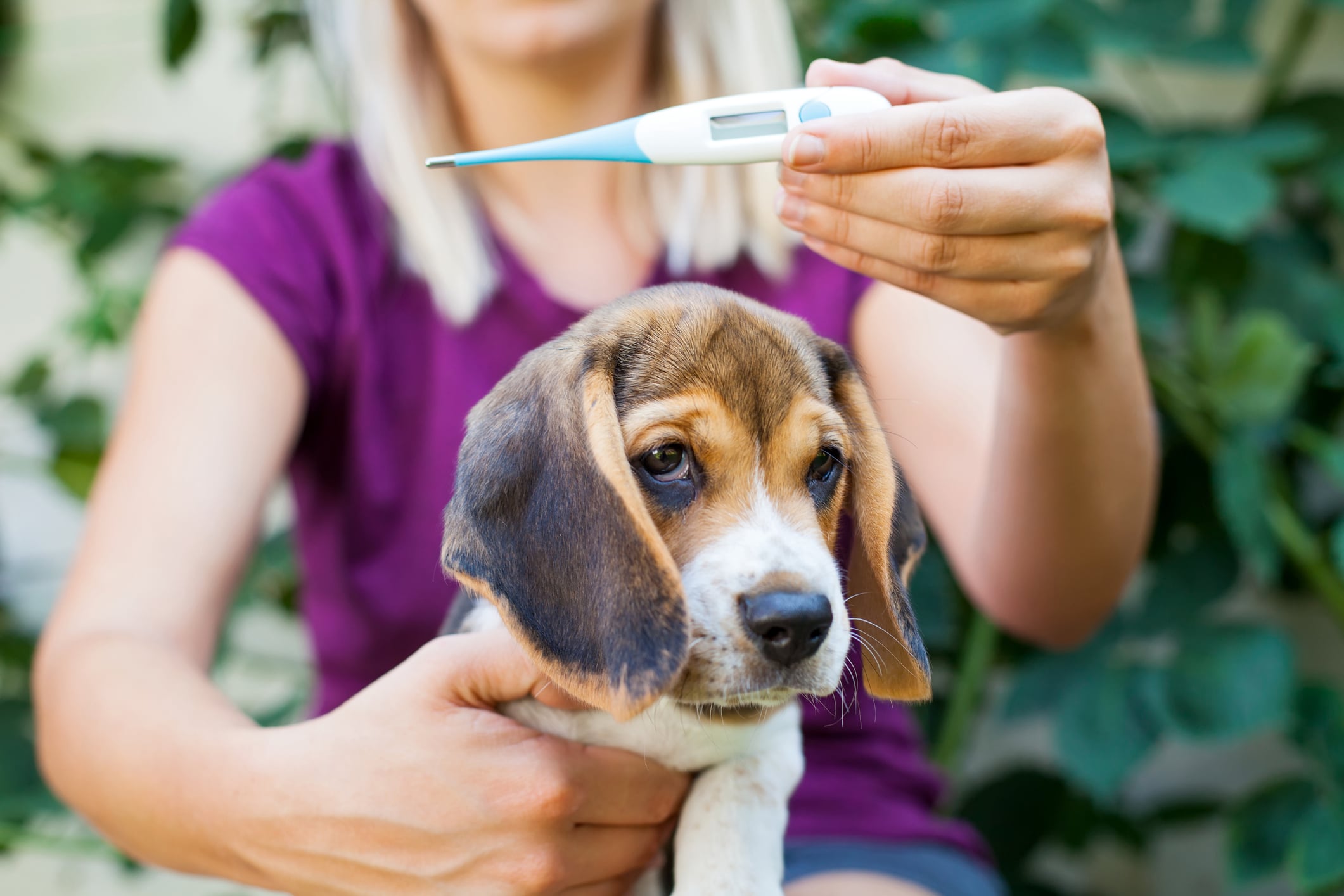In this article
Many pet owners become worried when they notice their pet feels hot to the touch. While it can be a sign of fever, there can be other reasons that your dog feels overly warm, because this is a very subjective measurement.
It’s possible that your dog feels warm because their body temperature is naturally higher than that of a human. Normal, healthy dogs have a body temperature between 100°F and 102.5°F, while in people this range is 97°F to 99°F. Especially if you have cold hands, your dog may feel hot to the touch because they ARE warmer than you.
If you think your dog feels warmer than normal, they could have an elevated body temperature. In this article, we’ll discuss five possible reasons your dog’s body temperature could be elevated, and what to do if your dog feels hot to the touch.
The 5 Possible Reasons Your Dog Feels Hot to the Touch
1. Exercise
This shouldn’t come as a surprise, but exercise increases the body surface temperature.1 If your dog has just been running around, their muscles have been working hard and producing heat as a byproduct of exercise. Increasing blood flow to the skin surface helps cool them off after exercise, as does panting.
If your dog feels hot after some vigorous exercise, this could be completely normal. You can offer them some cool water, wipe them with a cool water towel, and take them to a cool spot to rest and recover.

2. Heatstroke
Heatstroke is a severe condition caused by excessive heat exposure or physical exercise in hot conditions. Obese and brachycephalic (short-faced) dogs are more prone to heat stroke than other dogs. Heatstroke can lead to electrolyte depletion, dehydration, and organ damage if left untreated. Dogs suffering from this condition will have a body temperature of 104°F or more.
- Excessive panting
- Drooling
- Bright red gums
- Vomiting and diarrhea
- Weakness
- Collapse
- Disorientation or difficulty walking
- Seizures
Heatstroke can lead to death in some instances, so catching the signs early on and seeking veterinary help is crucial.
Did you know you can speak to a veterinarian without having to travel? Just head over to PangoVet. It's an online service where you can talk to a vet online and get the advice you need for your pet — all at an affordable price!

3. Stress
Stress, excitement, or agitation can increase your dog’s body temperature too. If they are shaking, pacing, or resisting restraint, their body temperature can rise noticeably. Look at your dog’s body language and try to determine what is causing their behavior. If they appear fairly calm and relaxed, they probably aren’t hot because of stress.

4. Local Inflammation
Inflammation is caused by the body’s immune system as it responds to a stimulus, illness or injury. Local inflammation can occur when the body responds to something in one particular area; blood supply to this area increases and it usually feels hot to the touch. The skin may become inflamed due to allergies, parasites, or infection. Injuries like ligament ruptures, sprains and burns can lead to inflammation in the affected area as well.
5. Fever
There are a huge number of diseases that can cause fever in dogs. Fever is a persistently high body temperature that is caused by an immune response.
- Bacterial infections e.g. a urinary tract infection, pneumonia
- Fungal infections e.g. aspergillosis
- Viral infections e.g. infectious tracheobronchitis (kennel cough)
- Auto-immune diseases e.g. immune-mediated hemolytic anemia, immune-mediated thrombocytopenia
- Cancer e.g. lymphosarcoma
- Pancreatitis
- Poisons e.g. snail bait toxicity

What To Do When Your Dog Feels Hot to the Touch
1. Stay Calm
If you notice your dog is hot to the touch, remain calm. Your dog can read your mood and could become stressed if you are stressed. You will need to take action to determine if they have a fever or could be sick.

2. Take note of their recent behaviors
Take notes of what your dog was doing in the last few hours; have they been running around, basking in a sunny spot, or anything else that could elevate their body temperature?
Have they shown any signs of illness? Signs to look for include:
- Inappetence
- Vomiting
- Diarrhea
- Lethargy
- Changes in urination
- Limping
- Coughing
- Panting
- Behavioral changes
3. Take their temperature
The best way to determine if your dog has a fever, is to take their temperature, if you feel it’s safe to do so. The most accurate reading is a rectal temperature. Hopefully you have a dog thermometer in your dog’s first aid kit. Lubricate the tip of the thermometer with some petroleum jelly and gently insert it 1-2 cm into their anus. Make sure the tip doesn’t sit in the feces as this can lead to a falsely low reading, but rather hold it against the rectal wall.
Some dogs will bite if you try to take their temperature. If you think your dog may bite you can either apply a muzzle, if they are accustomed to wearing one, or take them to the veterinarian. If a rectal temperature is not possible, you can place the tip of the thermometer under your dog’s armpit, right next to their chest, however this is less accurate and usually leads to a lower temperature reading.

4. Visit the veterinarian
If your dog has no signs of illness and a normal rectal temperature of 100°F to 102.5°F, you can continue to monitor them at home. It’s a good idea to repeat the temperature a few times, until you are satisfied your dog is completely fine.
If their rectal temperature was 102.6°F- 102.9°F, and they have no other signs but they have been engaging in activities that could elevate their body temperature, it’s a good idea to take them to a cool spot to rest. Offer some cool water and sponge them with some cool water, especially on the paws and belly. You should take their temperature again after 30 minutes to ensure it has come back down, and keep them rested under close observation for several hours.
If your dog has any other signs of illness, an unexplained elevated body temperature, or a body temperature of 103°F or more, you should seek urgent veterinary care. The vet will take a thorough history and examine your dog, including checking their rectal temperature. They will discuss next steps with you but may recommend some follow up tests like bloodwork or x-rays to diagnose your pet.
Your pet will be treated according to their diagnosis, but in general dog’s experiencing dehydration will need intravenous fluid therapy, ogs with bacterial infections will be prescribed antibiotics, and those with autoimmune diseases will need immunosuppressive medication.
In Conclusion
If your dog feels hot to the touch, it may not always mean they are ill. Dogs have a body temperature that is naturally hotter than ours. If your dog feels warmer than normal, you should monitor them for signs of illness and take their temperature if you can. A rectal temperature is an objective way to determine if their body temperature is elevated. A temperature over 103°F means your dog needs urgent veterinary care.
Featured Image Credit By: Ksenia Raykova, Shutterstock



















